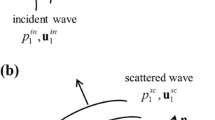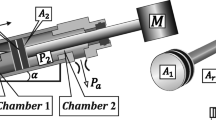Abstract
A new manually operated pressure driven shock tube is proposed and demonstrated. Shock wave-associated parameters like velocity, Mach number, pressure, and temperature are computed using acoustic method. Experiment involves manually loading train of pressure pulses into a driver tube using a bicycle pump. The high pressure buildup in driver tube ruptures the diaphragm at critical pressure and generates a propagating shock wave in the driven section coupled with sensor section in which a couple of microphones are separated by a fixed distance. The propagating shock wave acoustical profile is recorded and its arrival time lag is measured using sound recording software. In a conventional method, piezo-electric pressure sensors are utilized to measure both pressure and time lag of shock wave between the sensors. In the proposed method, microphones are utilized to measure time lag of shock wave with sampling frequency of 768 KHz using computer supporting audio software. Utilizing time data, the said shock wave parameters are evaluated and reported. The performance of the proposed shock tube is compared with manually operated piston-driven Reddy tube.






Similar content being viewed by others
References
Sudhieshkumar C, Reddy KPJ (2015) Experiment in hand-operated, hypersonic shock tunnel facility. Shock Waves 26:845–849. https://doi.org/10.1007/s00193-015-0608-x
Swietek B, Santhakumar V, Pfister B (2012) Table-top air pressure-driven shock tube toinduce a blast traumatic brain injury. IEEE 51-52(2012). https://doi.org/10.1109/NEBC.2012.6206957
Paterson RF, Lifshitz DA, Kuo RL, Siqueira TM Jr, Lingeman JE (2002) Shock wave lithotripsy monotherapy for renal calculi. Int Braz J Urol 28:291–301
Nossair AA, Eid MM, Salama AB (2013) Advanced protocol of shock wave therapy for diabetics foot ulcer. Am J Sci 9:633–636
NguyenTT N, WilgerothJ M, Proud WG (2014) Controlling blast wave generation in a shock for biological application. J Phys Conf Ser 500:142025. https://doi.org/10.1088/1742-6596/500/14/142025
Courtney E, Courtney A, Courtney M (2014) Shock tube for high intensity blast waves for laboratory testing of armor and combat material. Defen Tech 10:245–250. https://doi.org/10.1016/j.dt.2014.04.003
Reddy KPJ, Sharath N (2013) Manually operated piston-driven shock tube. Curr Sci 104:172–176
Kalaiarasi S, Sivakumar A, Martin Britto Dhas SA, Jose M (2018) Shock wave induced anatase to rutile TiO2 phase transition using pressure driven shock tube. Mater Lett 219:72–75. https://doi.org/10.1016/j.matlet.2018.02.064
Sivakumar A, Suresh S, Anto Pradeep J, Balachandar S, Martin Britto Dhas SA (2018) Effect of shock waves on dielectric properties of KDP crystal. J Elect Mater 17:4831–4839. https://doi.org/10.1007/s11664-018-6362-y
Sivakuamr A, Martin Britto Dhas SA (2019) Shock wave induced nucleation leading to crystallization in water. J Appl Cryst 52:1016–1021. https://doi.org/10.1107/S1600576719009488
Courtney M (2008) Acoustic methods for measuring bullet velocity. Appl Acoustic 69:925–928. https://doi.org/10.1016/j.apacoust.2007.05.004
Yuldashev P, Karzova M, Ollivier VKS, Blanc-Benon P (2015) Mach-Zehnder interferometry method for acoustic shock wave measurements in air and broadband calibration of microphones. J Acoust Soc Am 137:1–11. https://doi.org/10.1121/1.4921549
Chang H, Wu Y-C, Tsung T-T (2011) Characteristics and measurement of projectile shock waves by a 32- microphone ring array. Rev Sci Instrum 82:084902. https://doi.org/10.1063/1.3622044
Padhy S, Panigrahi S (2014) Measuring projectile velocity using shock wave pressure sensors. Def Sci J 64:499–501. https://doi.org/10.14429/dsj.64.8108
Funding
The authors thank the management of Sacred Heart College for the financial support through Don Bosco Research Grant (SHC/DB Grant/2017/01).
Author information
Authors and Affiliations
Corresponding author
Ethics declarations
Conflict of Interest
The authors declare that they have no conflict of interest.
Additional information
Publisher’s Note
Springer Nature remains neutral with regard to jurisdictional claims in published maps and institutional affiliations.
Highlights
✓ A new manually operated pressure-driven table-top shock tube using a bicycle pump is developed and tested.
✓ Shock wave related parameters are estimated using a microphone.
✓ Proposed shock tube is capable of producing Mach number above 2.
✓ Cost-effective method and suitable for laboratory/ research purposes.
Electronic Supplementary Material
ESM 1
(DOCX 11 kb)
Rights and permissions
About this article
Cite this article
Sivakumar, A., Balachandar, S. & Dhas, S.A.M.B. Measurement of “Shock Wave Parameters” in a Novel Table-Top Shock Tube Using Microphones. Hum Factors Mech Eng Def Saf 4, 3 (2020). https://doi.org/10.1007/s41314-019-0033-5
Received:
Revised:
Accepted:
Published:
DOI: https://doi.org/10.1007/s41314-019-0033-5




